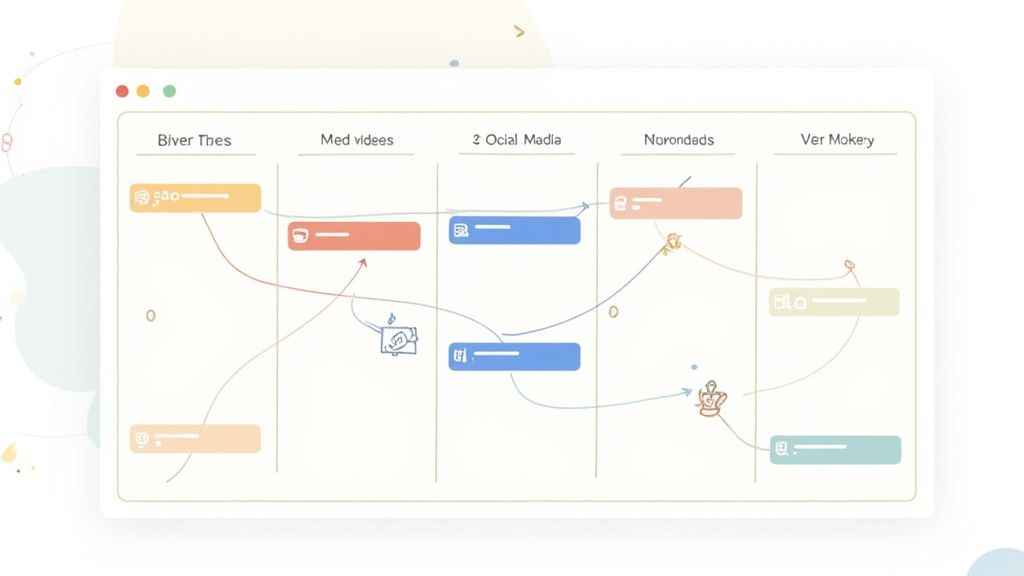In the competitive digital arena, creating content is just the starting point. The real differentiator between a brand that captures attention and one that gets lost in the noise is a commitment to strategic execution. A well-defined approach turns content from a simple brand asset into a powerful engine for growth, engagement, and authority. This guide is designed to move beyond surface-level tips and provide a detailed blueprint for implementing proven content marketing best practices.
We will explore 10 fundamental pillars that underpin successful campaigns, offering actionable insights you can apply immediately. This is not a theoretical overview; it is a practical playbook for building a content ecosystem that delivers tangible results. You will learn how to transform your efforts from scattered tactics into a cohesive, high-impact strategy that consistently attracts, engages, and converts your target audience.
Each section is structured to provide clarity and direct implementation guidance, covering everything from foundational audience research and strategic planning to sophisticated content optimization and performance analysis. By mastering these principles, you’ll be equipped to not only produce exceptional content but also to build a resilient brand presence that stands out. Whether you are refining a mature strategy or building one from the ground up, the following practices will provide the framework needed to achieve your marketing objectives and drive meaningful business outcomes.
1. Know Your Audience Through Detailed Buyer Personas
Effective content marketing begins with a deep, nuanced understanding of who you’re trying to reach. This is where creating detailed buyer personas becomes one of the most crucial content marketing best practices. A buyer persona is a semi-fictional representation of your ideal customer based on market research and real data about your existing customers. It goes far beyond basic demographics, diving into their goals, challenges, motivations, and daily routines.

This foundational practice ensures that every piece of content, from a blog post to a social media update, is precisely tailored to resonate with a specific audience segment. When you know “Marketing Mary’s” biggest pain point is proving ROI, you can create case studies and data-driven articles she’ll find invaluable. This targeted approach boosts engagement, builds trust, and ultimately drives conversions by making your audience feel truly understood.
Real-World Examples
- HubSpot: The company not only pioneered the widespread use of buyer personas but also provides comprehensive templates that thousands of marketers use to structure their research.
- Buffer: The social media management platform tailors its blog content to different personas, such as the “freelance social media manager” versus the “in-house enterprise team lead,” addressing their distinct needs and challenges.
How to Implement This Practice
To build effective personas, you must move beyond assumptions and gather tangible data. This process ensures your content strategy is built on a solid foundation of audience insight.
Expert Insight: “Personas are the foundation of a relevant content strategy. If you don’t know who you’re creating content for, you’re just creating noise.” – Ann Handley
Here are actionable steps to get started:
- Conduct Interviews: Speak directly with current and potential customers to understand their goals and pain points in their own words.
- Analyze Data: Use tools like Google Analytics and social media insights to identify demographic and behavioral trends among your audience.
- Create Negative Personas: Define who you are not targeting. This helps you refine your messaging and avoid wasting resources on unqualified leads.
- Update Regularly: Your audience evolves, and so should your personas. Review and update them at least quarterly with new data.
For a deeper dive into this topic, you can learn more about how to create buyer personas that drive results.
2. Develop a Comprehensive Content Strategy and Calendar
While creating great content is important, doing so without a plan is like navigating without a map. A comprehensive content strategy defines the what, when, where, and why of your content, while a content calendar provides the tactical framework for execution. This practice ensures every piece of content serves a specific purpose, aligns with business objectives, and consistently reaches your audience.

This strategic approach transforms content creation from a reactive task into a proactive, goal-oriented process. By planning content themes, topics, formats, and distribution schedules, you create a cohesive brand experience that builds momentum over time. This level of organization prevents last-minute scrambling and empowers your team to produce higher-quality work that supports broader marketing goals, making it one of the most critical content marketing best practices for sustainable growth.
Real-World Examples
- CoSchedule: The company built its entire business around this principle, offering a comprehensive content calendar platform that helps over 100,000 marketers plan, organize, and execute their strategies.
- Red Bull: The brand masterfully plans its content a year in advance around major extreme sports events, ensuring a constant stream of high-energy, relevant content that captivates its audience.
- Content Marketing Institute: As a leader in the field, CMI uses a detailed editorial calendar to manage its blog, webinars, research reports, and events, demonstrating strategic consistency.
How to Implement This Practice
Building an effective strategy and calendar requires foresight and collaboration. The goal is to create a living document that guides your team while remaining adaptable to new opportunities.
Expert Insight: “A content marketing plan is a map. It might not get you to your destination in a straight line, but it will keep you from getting lost.” – Joe Pulizzi
Here are actionable steps to get started:
- Plan in Advance: Aim to map out your content themes and major initiatives at least 3-6 months ahead. This allows for thorough research, production, and promotion.
- Conduct a Content Gap Analysis: Analyze your existing content and your competitors’ content to identify underserved topics that your audience cares about.
- Build in Flexibility: Leave room in your calendar to address trending topics, industry news, or unexpected opportunities. A rigid plan can cause you to miss out on relevant conversations.
- Coordinate Across Teams: Regularly sync your content calendar with sales, product, and customer service teams to ensure messaging is aligned with launches, promotions, and customer feedback.
For a deeper dive, explore how to build a content calendar that streamlines your workflow.
3. Focus on Quality Over Quantity
In an era of content saturation, one of the most impactful content marketing best practices is to prioritize creating high-value, deeply researched content over churning out a high volume of mediocre posts. This approach centers on the idea that one exceptional piece of content that truly serves your audience is far more valuable than dozens of superficial articles that fail to make an impact. It’s about becoming a trusted resource, not just a frequent publisher.

This quality-first mindset shifts the focus from vanity metrics like publication frequency to engagement metrics like time on page, social shares, and backlinks. By investing more resources into fewer pieces, you can create comprehensive guides, original research, and thought leadership that builds authority, attracts high-quality traffic, and serves as an evergreen asset that generates leads for years.
Real-World Examples
- Wait But Why: Tim Urban’s blog is famous for its incredibly long-form, deeply researched articles, complete with unique illustrations. These posts, published infrequently, often go viral and attract millions of views.
- First Round Review: This publication focuses on producing in-depth, actionable advice for the startup community. Its articles are treated like industry-defining resources, giving First Round Capital immense brand authority.
- Moz: Instead of publishing daily blog posts, Moz created foundational resources like “The Beginner’s Guide to SEO.” This single, high-quality asset has become a go-to resource, attracting countless backlinks and new customers.
How to Implement This Practice
Adopting a quality-over-quantity strategy requires a shift in mindset from a content calendar checklist to an investment in excellence. It means dedicating significant time and resources to make each piece a standout success.
Expert Insight: “Your goal should be to create the best content on the internet for your topic. If you can’t say that with confidence, go back and make it better.” – Brian Dean
Here are actionable steps to get started:
- Conduct Thorough Research: Go beyond a simple Google search. Interview experts, gather original data, and find unique angles to make your content truly comprehensive.
- Invest in Professional Editing and Design: A polished final product signals quality. Hire professional editors and designers to ensure your content is flawless and visually compelling.
- Include Actionable Insights: Don’t just explain a topic; show your audience how to apply the information. Use data, examples, and step-by-step instructions.
- Promote Heavily: A high-quality piece deserves a significant promotional effort. Spend as much, if not more, time promoting your content as you did creating it.
4. Optimize Content for Search Engines (SEO)
Creating amazing content is only half the battle; ensuring it gets discovered is the other. This is where optimizing for search engines (SEO) becomes one of the most essential content marketing best practices. It involves strategically creating and structuring your content so that it ranks highly in search engine results for relevant queries, driving valuable organic traffic to your site. This practice is a powerful fusion of art and science, balancing reader-centric value with technical precision to capture audience attention at the moment they are searching for solutions.

A strong SEO foundation ensures your content investment pays dividends long after publication. By aligning your content with what users are actively seeking, you attract a highly motivated audience. This not only boosts visibility and brand authority but also generates a sustainable stream of qualified leads, making SEO a non-negotiable component of a modern content strategy.
Real-World Examples
- Backlinko: Brian Dean’s blog is a masterclass in SEO, with in-depth guides that consistently rank #1 for hyper-competitive keywords like “link building” and “on-page SEO.”
- Canva: The design platform leverages SEO brilliantly by creating thousands of tutorials and templates that rank for user queries like “how to create a logo,” attracting millions of potential customers.
How to Implement This Practice
Integrating SEO requires a systematic approach that begins before you even write the first word. It’s about understanding search intent and building content that satisfies it better than anyone else.
Expert Insight: “The best place to hide a dead body is page two of Google.” – Anonymous (popularized by many SEO experts)
Here are actionable steps to get started:
- Conduct Keyword Research: Use tools like Ahrefs or SEMrush to identify the terms your target audience is searching for. Focus on topics with a good balance of search volume and achievable difficulty.
- Optimize for User Intent: Go beyond just keywords. Understand why someone is searching for a term. Are they looking for information, a direct purchase, or a comparison? Tailor your content to match that intent.
- Create Topic Clusters: Organize your content around a central “pillar” page for a broad topic, linking out to more specific “cluster” articles. This structure signals your authority on the subject to search engines.
- Monitor and Update: SEO is not a “set it and forget it” task. Regularly track your content’s performance using Google Analytics and Search Console. Update and refresh older posts to keep them relevant and competitive.
5. Create Valuable, Educational Content That Solves Problems
The core of modern content marketing lies in generosity. Instead of pushing a hard sell, this best practice focuses on creating content that genuinely helps your audience by solving their specific problems, answering their questions, and teaching them valuable skills. This educational approach shifts your brand’s role from a seller to a trusted advisor, building deep, long-lasting relationships based on value rather than transactions.
By consistently providing utility, you attract a loyal following that sees your brand as the go-to resource in your industry. This strategy, famously championed by Marcus Sheridan in his book “They Ask, You Answer,” generates highly qualified leads because the audience has already received tangible value from you before ever considering a purchase. It’s one of the most effective content marketing best practices for establishing authority and earning trust.
Real-World Examples
- Salesforce: The company’s Trailhead platform is a masterclass in educational content, offering free courses that teach users valuable CRM and business skills, directly aligning with their product ecosystem.
- Mint: The financial app built its brand by creating a massive library of content that educates users on personal finance topics like budgeting and investing, helping them solve real money problems.
How to Implement This Practice
To create truly helpful content, you must adopt an “audience-first” mindset. Your primary goal is to serve their needs, with the understanding that this service will eventually lead to business growth.
Expert Insight: “Stop selling. Start helping.” – Jay Baer
Here are actionable steps to put this into practice:
- Identify Pain Points: Listen intently to your sales and customer service teams to identify the most common questions and challenges your customers face.
- Create Resource Libraries: Develop comprehensive guides, tutorials, and how-to articles that act as definitive resources on key topics in your niche.
- Use Multiple Formats: Explain complex concepts using a mix of formats, including blog posts, videos, webinars, and downloadable checklists, to cater to different learning styles.
- Survey Your Audience: Directly ask your audience what they want to learn about. Use surveys and social media polls to generate a backlog of relevant content ideas.
6. Utilize Multiple Content Formats and Channels
Relying on a single content format or distribution channel significantly limits your reach and impact. One of the most effective content marketing best practices is to diversify your content across various formats like blog posts, videos, podcasts, and infographics. This multi-format, multi-channel approach caters to diverse audience preferences, ensuring your message resonates whether your audience prefers reading, watching, or listening.
This strategy maximizes the value of every core content idea by adapting it for different platforms. A detailed webinar can become a series of short video clips for social media, a summary blog post, and an audio-only podcast episode. By meeting your audience where they are and in the format they prefer, you increase engagement, reinforce your message through multiple touchpoints, and build a more resilient and far-reaching content ecosystem.
Real-World Examples
- Gary Vaynerchuk: He famously champions the “content pyramid” model, where one long-form video or keynote is repurposed into dozens of smaller content pieces (clips, quotes, articles, images) for distribution across all social platforms.
- HubSpot: The company excels at an integrated strategy, where a single research report can fuel blog articles, an educational video series, a podcast discussion, and social media infographics, all leading back to the original asset.
How to Implement This Practice
Successfully diversifying content requires a strategic and systematic approach, not just creating more for the sake of it. The goal is to work smarter by amplifying your best ideas across the digital landscape.
Expert Insight: “Your best-performing content deserves to be repurposed. Turn your top blog post into a video, an infographic, or a podcast episode. This isn’t about creating more content; it’s about getting more mileage out of your best content.” – Jay Baer
Here are actionable steps to get started:
- Start with One “Pillar” Format: Focus on creating one high-quality, in-depth piece of content (e.g., a webinar, research report, or ultimate guide).
- Repurpose Strategically: Break down your pillar content into smaller, derivative assets. A single guide can become ten social posts, three short videos, and a checklist.
- Track Channel Performance: Use analytics to identify which channels and formats drive the most engagement for your audience. Double down on what works and experiment with new platforms.
- Maintain a Consistent Brand Voice: Ensure your brand’s tone, messaging, and visual identity remain consistent across every format and channel to build a cohesive brand experience.
To further develop your approach, you can learn more about effective content distribution strategies.
7. Measure and Analyze Content Performance with Data
Creating great content is only half the battle; understanding its impact is what separates successful strategies from wasted effort. This is why a data-driven approach to measurement is one of the most essential content marketing best practices. It involves moving beyond vanity metrics and tracking key performance indicators (KPIs) that directly tie your content efforts to tangible business objectives, such as lead generation, sales, and customer retention.
This practice transforms content marketing from a creative guessing game into a predictable, scalable engine for growth. By consistently analyzing what works and what doesn’t, you can systematically optimize your strategy, double down on high-performing topics and formats, and justify your marketing budget with clear evidence of ROI. It ensures every piece of content serves a purpose and contributes measurably to your goals.
Real-World Examples
- BuzzFeed: The media giant famously uses A/B testing and deep data analysis to understand what makes content shareable, refining headlines, formats, and topics to maximize virality.
- Netflix: The streaming service’s recommendation engine is a masterclass in data analysis, using viewer data to not only suggest content but also to inform the creation of new original shows and movies.
How to Implement This Practice
To effectively measure performance, you need a clear framework for tracking, analyzing, and acting on data. This process ensures your insights translate into meaningful strategic adjustments.
Expert Insight: “What can be measured can be improved. Without data, you are just another person with an opinion.” – W. Edwards Deming
Here are actionable steps to get started:
- Align Metrics with Goals: Define specific KPIs for each stage of the funnel. For awareness, track traffic and reach; for consideration, track leads and time on page; for conversion, track sales and sign-ups.
- Set Up Proper Tracking: Implement tools like Google Analytics, Search Console, and marketing automation platforms to establish a reliable system for data collection and attribution.
- Establish Regular Reporting: Create a consistent schedule (weekly or monthly) to review performance dashboards and share key insights with stakeholders.
- Use Insights to Optimize: Don’t just collect data, act on it. Use your findings to refine your content calendar, update old posts, and experiment with new formats.
For a comprehensive guide, you can learn more about how to analyze content performance in detail.
8. Build Community and Encourage User-Generated Content
One of the most powerful content marketing best practices is to transform your audience from passive consumers into active participants. This involves fostering a genuine community around your brand and encouraging user-generated content (UGC), where your customers create and share content featuring your products or services. This strategy builds unparalleled brand loyalty and leverages customer advocacy for authentic, trust-building marketing assets.
When customers become part of a community, they feel a deeper connection to your brand that transcends simple transactions. UGC serves as powerful social proof, as potential buyers trust recommendations from real people far more than they trust traditional advertising. This approach turns your audience into a volunteer marketing force, generating a steady stream of genuine content that promotes your brand organically.
Real-World Examples
- GoPro: The brand built its entire content strategy around showcasing thrilling, high-quality videos filmed by its users. This not only provided a constant flow of engaging content but also perfectly demonstrated the product’s capabilities in real-world scenarios.
- Starbucks: Their annual #RedCupContest on Instagram encourages customers to share creative photos of their holiday-themed cups, generating thousands of free, festive brand mentions each year.
- Glossier: The beauty brand cultivated a dedicated community that shares product reviews, makeup tutorials, and testimonials, effectively making its customers its most influential brand ambassadors.
How to Implement This Practice
Successfully launching a UGC campaign requires creating a clear framework that makes it easy and rewarding for your audience to participate. The goal is to inspire creativity while ensuring the content aligns with your brand.
Expert Insight: “Your customers are your best storytellers. Empower them, celebrate them, and they will build your brand for you.” – Emily Weiss
Here are actionable steps to get started:
- Create Clear Guidelines: Establish a unique and memorable hashtag for your campaign and provide simple instructions on what kind of content you’re looking for.
- Recognize and Reward: Feature the best submissions on your official channels, offer prizes for top content, or give shout-outs to active community members to incentivize participation.
- Engage Actively: Respond promptly to submissions and community interactions. Like, comment on, and share user posts to show appreciation and foster a two-way conversation.
- Always Ask for Permission: Before repurposing user-generated content for your marketing materials, such as on your website or in ads, always reach out and obtain explicit permission.
9. Maintain Consistent Brand Voice and Messaging
One of the most powerful content marketing best practices is ensuring your brand speaks with a single, recognizable voice across every channel. Brand consistency means all your content, from a tweet to a detailed white paper, reflects the same personality, tone, values, and messaging. This creates a cohesive and predictable experience for your audience, which is fundamental to building brand recognition and trust.
When your voice is consistent, your audience knows what to expect. This reliability makes your brand feel more authentic and dependable, transforming casual readers into a loyal community. A consistent voice reinforces your brand identity at every touchpoint, strengthening recall and differentiating you from competitors in a crowded marketplace. It ensures your message is not just heard, but remembered.
Real-World Examples
- Mailchimp: Famously uses a quirky, friendly, and encouraging voice across its website, emails, and social media. This approachable tone makes marketing automation feel less intimidating for small businesses.
- Nike: Consistently employs an inspirational and motivational tone, using powerful words and stories of athletic achievement to embody its “Just Do It” philosophy across all campaigns.
- Apple: Maintains a minimalist, confident, and innovation-focused voice. Its product descriptions and marketing copy are simple, direct, and centered on user benefits and cutting-edge design.
How to Implement This Practice
Establishing and maintaining a consistent brand voice requires a deliberate, documented process. It ensures every team member, from marketers to customer service agents, communicates as a unified brand.
Expert Insight: “A brand’s voice is its personality in the marketplace. If that personality is inconsistent, the brand becomes forgettable and untrustworthy.” – David Aaker
Here are actionable steps to get started:
- Create Brand Guidelines: Develop a comprehensive document detailing your brand’s tone of voice, personality traits, grammar rules, and a “words we use/don’t use” list.
- Train All Content Creators: Ensure every employee, freelancer, and agency partner is trained on your brand voice guidelines before they create any content.
- Conduct Regular Audits: Periodically review all content across your channels to check for consistency and identify areas where your messaging has drifted.
- Apply Voice Everywhere: Extend your brand voice beyond marketing to include customer service interactions, email signatures, and internal communications for true cohesion.
10. Repurpose and Maximize Content Value
Creating high-quality content requires a significant investment of time and resources. One of the most effective content marketing best practices is to maximize that investment through repurposing. Content repurposing involves transforming a single piece of content into multiple formats, adapting it for different channels, and reaching diverse audience segments with unique preferences for consumption.
This strategic approach extends the lifespan and reach of your best work. Instead of adopting a “create and forget” mentality, you build a content ecosystem where a single core idea, like an in-depth research report, can fuel your social media, email newsletters, and video channels for weeks. This not only improves efficiency but also reinforces your core message across various touchpoints, strengthening brand authority and recall.
Real-World Examples
- Tim Ferriss: The author and podcaster masterfully repurposes his long-form podcast interviews into blog posts, quote graphics for social media, email newsletter highlights, and even content for his popular books.
- Harvard Business Review: HBR transforms dense academic research papers into more accessible formats like articles, infographics, podcasts, and short animated videos, catering to different learning styles and levels of engagement.
- TED Talks: A single 18-minute talk is repurposed into a full transcript, a standalone article, dozens of shareable video clips for social media, and quote cards, amplifying its message far beyond the original presentation.
How to Implement This Practice
Effective repurposing isn’t just copying and pasting. It requires a thoughtful adaptation of the core message to fit the context and audience of each new platform. This ensures every piece feels native to its channel.
Expert Insight: “Don’t create net new content all the time. Instead, take your ‘pillar’ content and atomize it into dozens of smaller pieces of micro-content.” – Gary Vaynerchuk
Here are actionable steps to get started:
- Identify Top Performers: Use analytics to find your most popular and evergreen content. These “pillar” pieces are the ideal candidates for repurposing.
- Design for Repurposing: When creating new pillar content, think ahead. Outline potential spin-offs like infographics, checklists, or social media carousels from the very beginning.
- Adapt Meaningfully: Tailor the format and tone for each channel. A formal webinar can become a casual Q&A on Instagram Stories, while key data points can be turned into a professional infographic for LinkedIn.
- Track Performance: Monitor the engagement of each repurposed asset to understand which formats and channels resonate most, allowing you to refine your future content multiplication strategy.
Content Marketing Best Practices Comparison
| Practice | Implementation Complexity 🔄 | Resource Requirements ⚡ | Expected Outcomes 📊 | Ideal Use Cases 💡 | Key Advantages ⭐ |
|---|---|---|---|---|---|
| Know Your Audience Through Detailed Buyer Personas | Medium – requires upfront research and updates | Moderate – research tools and interviews | More targeted, relevant content; improved conversion | Audience segmentation and targeted marketing | Increases engagement; reduces wasted spend |
| Develop a Comprehensive Content Strategy and Calendar | High – extensive planning and coordination | High – team collaboration and tools | Consistent publishing; aligned with business goals | Long-term content planning and cross-team efforts | Prevents last-minute panic; optimizes resource use |
| Focus on Quality Over Quantity | Medium – detailed research and editing | High – time and expertise per content piece | Stronger brand authority; higher engagement | Brands prioritizing authority and evergreen content | Builds trust; improves SEO and sharing |
| Optimize Content for Search Engines (SEO) | Medium – ongoing technical and content updates | Moderate – SEO tools and expertise | Increased organic traffic; sustained visibility | Increasing organic reach and search rankings | Cost-effective; targets high-intent audiences |
| Create Valuable, Educational Content That Solves Problems | Medium – requires subject matter expertise | Moderate – research and varied formats | Builds trust; fosters loyal community | Educational brands and B2B lead generation | Positions brand as authority; high engagement |
| Utilize Multiple Content Formats and Channels | High – diverse skill sets and channel management | High – multimedia creation and distribution | Maximized reach and accessibility | Multi-platform and varied audience preferences | Expands brand visibility; increases ROI via repurposing |
| Measure and Analyze Content Performance with Data | Medium – requires analytics skills and tools | Moderate – analytics platforms and training | Data-driven improvements; clear ROI | Optimization-focused marketing teams | Enables continuous optimization; budget justification |
| Build Community and Encourage User-Generated Content | Medium – ongoing community management | Moderate – social platforms and moderation | Increased engagement and authentic advocacy | Brands valuing customer interaction and loyalty | Reduces content load; builds trust and insights |
| Maintain Consistent Brand Voice and Messaging | Medium – needs guidelines and training | Moderate – documentation and audits | Strong brand recognition and trust | All brands wanting cohesive customer experience | Enhances differentiation; professional image |
| Repurpose and Maximize Content Value | Medium – strategic planning for multiple formats | Moderate – adaptation and tracking | Improved ROI; broader audience reach | Content-rich brands maximizing existing assets | Saves time/resources; reinforces messages |
Putting Theory into Action: Your Next Steps in Content Marketing
You’ve just navigated a comprehensive blueprint of content marketing best practices, from building detailed buyer personas to the strategic art of repurposing your most valuable assets. The journey through these ten pillars reveals a powerful truth: exceptional content marketing isn’t about a single magic bullet. It is the result of a cohesive, dynamic system where each component strengthens the others.
Understanding your audience is the foundation, a content strategy is your architectural plan, and SEO is the framework that ensures your creation is discoverable. But without the high-quality, valuable content that solves real problems, the structure remains empty. This is where your commitment to excellence truly shines.
From Knowledge to Mastery: A Quick Recap
The principles we’ve covered are not just a checklist to be completed once. They are a cycle of continuous improvement. Let’s distill the core takeaways:
- Audience First, Always: Every decision, from topic ideation to channel selection, must start and end with a deep, empathetic understanding of your target audience. Your personas are not static documents; they are living guides for your entire strategy.
- Strategy Over Tactics: Random acts of content creation lead to wasted resources and inconsistent results. A documented strategy and an editorial calendar transform your efforts from a gamble into a calculated, predictable engine for growth.
- Data is Your Compass: Your analytics are not just for monthly reports. They are your guide, telling you what’s working, what’s not, and where to pivot. Regularly measuring performance is non-negotiable for sustained success.
- Value is the Ultimate Currency: In a saturated digital landscape, the only way to earn attention is to provide genuine value. Whether you’re educating, solving a problem, or entertaining, your content must leave your audience better off than they were before.
Your Actionable Path Forward
Reading about these content marketing best practices is the first step, but implementation is what separates the successful from the stagnant. To avoid feeling overwhelmed, focus on an iterative approach. You don’t need to perfect all ten areas overnight.
- Conduct a Content Audit: Start by assessing your current efforts against the principles in this article. Where are your biggest gaps? Is your brand voice inconsistent? Are you neglecting SEO? Identify one or two key areas for immediate improvement.
- Choose One Core Practice to Master This Quarter: Perhaps you’ll dedicate the next 90 days to building out incredibly detailed buyer personas through customer interviews. Or maybe your focus will be on establishing a robust system for measuring and analyzing content performance.
- Commit to Consistency: The most significant gains in content marketing come from sustained, consistent effort over time. Commit to your editorial calendar, publish regularly, and make data analysis a recurring ritual for your team.
Ultimately, mastering these concepts is about transforming your marketing from a cost center into a powerful revenue driver. It’s about building a brand that people trust, a community that advocates for you, and a predictable pipeline of leads and customers. This strategic approach elevates your brand above the noise, fostering loyalty and establishing you as a definitive authority in your industry. It’s a long-term investment that pays compounding dividends in brand equity, customer relationships, and business growth.
Navigating this complex process and integrating all these content marketing best practices into a cohesive plan can be a significant challenge. The expert team at ReachLabs.ai leverages data-driven insights and creative execution to build and implement tailored strategies that deliver measurable results. If you’re ready to transform your content into a powerful engine for growth, let’s connect and build a strategy that achieves your unique goals. ReachLabs.ai





